The ultimate guide to the LHC
 More information, facts and figures on the LHC can be found in CERN FAQ – LHC the guide.
More information, facts and figures on the LHC can be found in CERN FAQ – LHC the guide.
This website is no longer maintained. Its content may be obsolete. Please visit http://home.cern for current CERN information.
The precise circumference of the LHC accelerator is 26 659 m, with a total of 9300 magnets inside. Not only is the LHC the world’s largest particle accelerator, just one-eighth of its cryogenic distribution system would qualify as the world’s largest fridge. All the magnets will be pre‑cooled to -193.2°C (80 K) using 10 080 tonnes of liquid nitrogen, before they are filled with nearly 120 tonnes of liquid helium to bring them down to -271.3°C (1.9 K).
At full power, trillions of protons will race around the LHC accelerator ring 11 245 times a second, travelling at 99.9999991% the speed of light. Two beams of protons will each travel at a maximum energy of 7 TeV (tera-electronvolt), corresponding to head-to-head collisions of 14 TeV. Altogether some 600 million collisions will take place every second.
To avoid colliding with gas molecules inside the accelerator, the beams of particles travel in an ultra-high vacuum – a cavity as empty as interplanetary space. The internal pressure of the LHC is 10-13 atm, ten times less than the pressure on the Moon!
The LHC is a machine of extreme hot and cold. When two beams of lead ions collide, they will generate temperatures more than 100 000 times hotter than the heart of the Sun, concentrated within a minuscule space. By contrast, the 'cryogenic distribution system', which circulates superfluid helium around the accelerator ring, keeps the LHC at a super cool temperature of -271.3°C (1.9 K) – even colder than outer space!
To sample and record the results of up to 600 million proton collisions per second, physicists and engineers have built gargantuan devices that measure particles with micron precision. The LHC's detectors have sophisticated electronic trigger systems that precisely measure the passage time of a particle to accuracies in the region of a few billionths of a second. The trigger system also registers the location of the particles to millionths of a metre. This incredibly quick and precise response is essential for ensuring that the particle recorded in successive layers of a detector is one and the same.
The data recorded by each of the big experiments at the LHC will fill around 100 000 dual layer DVDs every year. To allow the thousands of scientists scattered around the globe to collaborate on the analysis over the next 15 years (the estimated lifetime of the LHC), tens of thousands of computers located around the world are being harnessed in a distributed computing network called the Grid.
 More information, facts and figures on the LHC can be found in CERN FAQ – LHC the guide.
More information, facts and figures on the LHC can be found in CERN FAQ – LHC the guide.